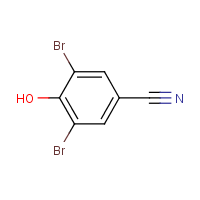Bromoxynil
Agent Name
Bromoxynil
CAS Number
1689-84-5
Formula
C7-H3-Br2-N-O
Major Category
Pesticides

Synonyms
2,6-Dibromo-4-cyanophenol; 3,5-Dibromo-4-hydroxybenzonitril (CAN); 3,5-Dibromo-4-hydroxybenzonitrile; 3,5-Dibromo-4-hydroxyphenyl cyanide; 3,5-Dibromo-4-hydroxyphenylcyanide; 4-Cyano-2,6-dibromophenol; 4-Hydroxy-3,5-dibromobenzonitrile; Benzonitrile, 3,5-dibromo-4-hydroxy-; Brittox; Brominal; Brominal Industrial; Brominal Plus; Brominal Triple; Brominex; Brominil; Bromotril; Bromoxynil (CAN); Bromoxynil [ANSI]; Broxynil; Buctril; Buctril industrial; Certrol B; Chipco buctril; Chipco crab-kleen; ENT 20852; Labuctril; Labuctril 25; Litarol M; M&B 10731; MB 10064; ME 4 Brominal; NU-Lawn weeder; Novacorn; Oxytril M; Pardner; S 2132; Sabre; Terset; Toplan; [ChemIDplus]
Category
Herbicides, Other
Description
Colorless, white, beige, or slightly yellow odorless solid; [HSDB] Off-white powder; [MSDSonline]
Sources/Uses
Used as post-emergence contact herbicide for cereals, conservation land, seedling alfalfa, field corn, popcorn, and other crops; [HSDB]
Comments
Mildly irritating to eyes and abraded skin of rabbits; No significant adverse effects were observed in a three month high-dose feeding study with rats; Dermal and inhalation studies with 10% solution had the same outcome; "Four workers in a manufacturing plant making both bromoxynil and ioxynil developed typical symptoms of uncoupler poisoning including excessive perspiration, thirst, fever, emesis, myalgia, and weight loss. ... The effects reversed rapidly after exposure ceased." [HSDB] May cause skin sensitization; [eChemPortal: ESIS] An irritant; May cause skin sensitization; [MSDSonline] Effects in high-dose animal studies include changes in structure or function of salivary glands, zonal hepatitis (hepatocellular necrosis), and other changes to liver; [RTECS] At maternally toxic doses in rodents, supernumerary ribs and reduced fetal weights were observed; No human pregnancy effects are known; [REPROTOX] See "Benzonitrile."
Reference Link #1
Biomedical References
Exposure Assessment
PEL (OSHA)
5 mg/m3, as CN
MAK
2 mg/m3, inhalable fraction, as CN
Vapor Pressure
4.72E-08 mm Hg
Lethal Concentration
LC50 (rat) = 150 mg/m3
Adverse Effects
Hepatotoxin
Hepatoxic (a) from occupational exposure (secondary effect) or (b) in animal studies or in humans after ingestion
Nephrotoxin
Yes
Other Poison
Uncoupler
Diseases, Processes, and Activities Linked to This Agent
Diseases
Occupational diseases associated with exposure to this agent:
Processes
Industrial Processes with risk of exposure: